Availability
![]() Distribution
Distribution
![]() News
News
![]() Notes & Interesting Articles
Notes & Interesting Articles
![]()
![]() Pricing
Pricing
![]() Products
Products
Accessories and Options
![]() Mounts
Mounts
![]() Mount Control Systems
Mount Control Systems
![]() Telescopes
Telescopes

ASTRO-PHYSICS OVERVIEW
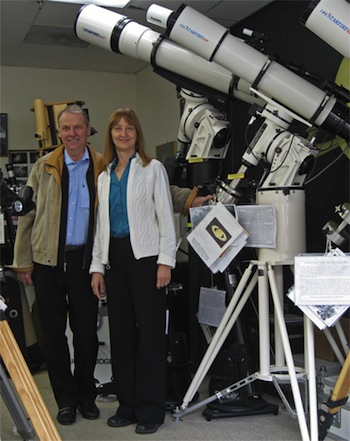 ASTRO-PHYSICS was founded by Roland and Marj Christen who have been developing telescopes and accessories for the advanced amateur since 1975. The company has featured prominently at the forefront of optical design since the early 1980's when their telescopes first began to earn the company acclaim.
ASTRO-PHYSICS was founded by Roland and Marj Christen who have been developing telescopes and accessories for the advanced amateur since 1975. The company has featured prominently at the forefront of optical design since the early 1980's when their telescopes first began to earn the company acclaim.
Up to the time when the Astro-Physics company was founded the refracting telescopes available up to then were achromatic designs that showed significant chromatic aberration, typically made with focal ratios as long as f/15. These telescopes are lengthy and awkward to manage, this is particularly a hindrance if portability is desired. Both five inch f/15 or 6 inch f/15 doublet achromat telescope optical tube assemblies (focal lengths of 75 and 90 inches respectively) require a substantially massive mount atop a tall pier or tripod to accommodate the length of the instrument and counteract the torque reactions of such lengthy telescopes. Their comparatively long focal ratios and residual chromatic aberration limited their astrographic usefulness, and that coupled with the length and weight of these instruments and their mount with tall pier deterred amateurs from transporting refractors larger than about four inch. Any of the better-made achromatic telescopes made, including Unitron for example, were comparatively costly telescopes. Their cost of five inch and larger models limited their sales to the more affluent consumer, or schools. Roland and Marj Christen with their company would change all that.
Right: Roland and Marj Christen alongside several of their telescopes and mounts, visiting Company Seven's showroom on 2 April 2009 (55,845 bytes).
Click on image to see enlarged view (169,585 bytes).
Roland Christen is an avid amateur astronomer who founded his original shop in Rockford, Illinois retailing astronomical telescopes for the amateur astronomy market. Among the products sold there were Celestron telescopes and accessories, among others. Roland developed and manufactured several models of electronic drive correctors and inverters for the telescope marketplace from the mid to late 1970s. These allowed the consumer to operate their telescopes, then mostly incorporating an AC synchronous motor, in the field from 12 volt DC sources. Furthermore, the Drive Corrector allows one to vary the telescope motor speed and thus vary the tracking rate (Solar, Sidereal, or Lunar) and make momentary adjustments to the tracking precision of the telescope drive. These were the first products to bear the "Astro-Physics" trademark, and were advertised in the popular astronomy magazine of the day. Roland's background in electronics would become apparent to us at Company Seven years later as we observed the high design standards and excellent qualities of materials and programming employed by Astro-Physics in the electronics of their later equatorial mount drive motors and drive control components. This experience and discipline remains apparent the still unrivaled 'GTO' electronics that control their 'go to' series of German Equatorial Mounts.
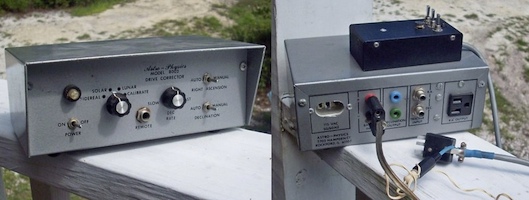
Click on image to see enlarged view (170,041 bytes).
Roland Christen outgrew the limited performance of consumer telescopes that were then available. He sought out telescopes that would be more versatile and produce views and astrophotographs that with striking contrast and clarity of stars and with high definition planetary images; this pointed towards a refracting telescope design. He understood that even the achromatic refractors then available showed 'snappier' images than that provided by his 8 inch Schmidt-Cassegrain telescope, but he wanted a more versatile telescope than the lengthy f/12 to f/15 achromatic refracting telescopes that were typical of the time. Roland began experimenting with triplet lens designs, the triplet offering the capability of bending light over shorter length optical tubes with less adverse impact on the final image. But triplet lenses were notoriously difficult to manufacture, especially in series production. Regardless, over a period of several years he designed and built several triplet refractors with shorter focal ratios than what was then common in production. The color correction was very good, even with lenses he made as short as f/6. Roland would make a new telescope, take it to a star party or amateur astronomer convention (Stellafane, etc.), and there let people look through the telescope while taking note of their feedback.
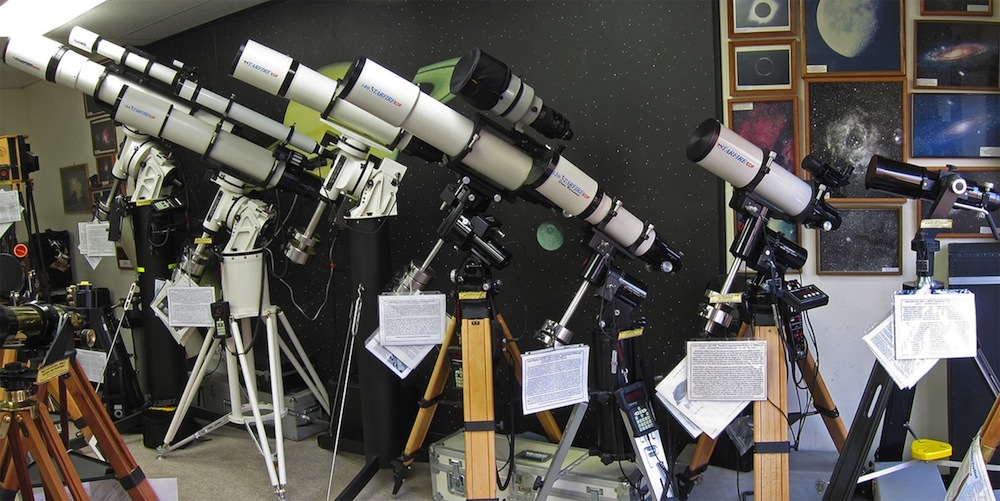
Above: "Refractor Row" is just part of what awaits those making the pilgrimage to Company Seven's showroom, the first and sole full-line Astro-Physics retailer in the Americas (210,126 bytes).
Left to right: AP 206mm EDF atop 1200GTO mount, 160mm EDF on 900GTO with Particle Wave "Pinnacle" tripod, 155mm EDF on original 900GTO and pier, 140mm EDF on Mach1GTO and wood tripod,
130mm EDF 'Gran Turismo' with 400GTO mount on 'Eagle Pier', 130mm EDF (Serial No. 1 - 1st production lens) on 400QMD mount and tripod, 105mm EDT "Traveler" (one of the two prototypes, this one
made for Martin of Company Seven). Piggybacked atop the 140mm EDF is a rare (one of Appx. 24 made) Nikon 300mm T2.2 (300mm f/2) EDIF Lens - a 160mm f/2!
Click on image to see enlarged view (832,511 bytes).
He developed several new lens designs for production that became prominent among the amateur astronomy community. Telescopes of note included the five and six inch aperture f/6 'Wide Field' and f/8 'Christen Triplet' telescopes, the five and six inch aperture f/12 'Super Planetary' series; by the late 1980's the Astro-Physics name was on the path to notoriety. It was these photos and a five inch f/12 'Super Planetary', the first Astro-Physics telescope evaluated by Company Seven, that in July 1986 cemented what would become a long friendship and business relationship between the two companies owners. Company Seven remains the sole full-line retailer of Astro-Physics products in the Americas, also serving a world-wide clientele.
Soon after then Tony Hallas and Daphne Mount started turning in astrophotographs taken with these telescopes; many of these were published in the popular astronomy magazines prompting even more people to seek out the Astro-Physics telescopes. By using the then state of the art Pentax 6x7 film cameras with hypersensitized films, and with longer exposure times than were then typical of the time they produced amazing wide-field of view astrophotos that attracted even more attention to the line and provided feedback to Roland and Marj Christen. These early Astro-Physics refractors were quite revolutionary and were a major influence in the rebirth of refractors at a time when mass-produced Schmidt-Cassegrain telescopes had become all the rage.
In the 1986 Astro-Physics introduced the 'Starfire' triplet apochromat series including the 5.6" F/7 Starfire sold in 1986 and 1987. This was their first high performance yet comparatively affordable line of triplet apochromatic refracting telescopes. We sensed Astro-Physics was being built on the popularity of the 5" F/8 Starfire, 6" f/9 Starfire, and 7" f/9 Starfire telescopes; the 7" completed in November 1988 for Company Seven's owner is now a featured telescope of the University of Maryland, College Park observatory facility. Even these earlier Astro-Physics lenses attracted the attention of third parties who purchased lenses for O.E.M. applications; this included the 94mm and later the 130mm "Brandon" telescopes. In August 1987 Astro-Physics relocated to their first facility that could truly be called a factory capable of managing most aspect of production. By 1989 lead times were becoming increasingly longer as more and more people put in deposits, then 1/3 later and since 1/2, to buy a new Astro-Physics telescopes.
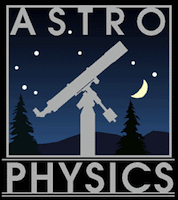 The availability of new extra-low dispersion optical glass types developed in particular by Nikon and Canon for state of the art camera lenses, and in higher purity grades, with improvements in computer aided lens design software combined with the extensive experience and customer feedback at Astro-Physics to the development of the landmark 'Starfire EDF' series triplet apochromat telescopes. On 1 December 1989 the first Starfire EDF telescope, the Astro-Physics 6 inch EDF, an f/7 triplet apochromat with 4 inch diameter field flattener and focuser, was announced and shown at Company Seven's "Astro-Physics Day" event; Company Seven remaining their first and still sole full line retailer in the Americas. Shown alongside it were stunning astrophotographs taken with one of these first two prototype telescopes by Tony Hallas and Daphne Mount. The EDF series announced in 1989 set the standard for an entirely new level of optical performance and versatility. These lenses were matched only by the 'APQ' series 150mm f/8 triplet apochromat telescopes made in small numbers by the then Carl Zeiss Jena concern of East Germany, although the Astro-Physics were more practical telescopes and better supported with a growing line of visual and astrographic accessories. The EDF is the telescope that put Astro-Physics unquestionably at the forefront of Apo tech.
The availability of new extra-low dispersion optical glass types developed in particular by Nikon and Canon for state of the art camera lenses, and in higher purity grades, with improvements in computer aided lens design software combined with the extensive experience and customer feedback at Astro-Physics to the development of the landmark 'Starfire EDF' series triplet apochromat telescopes. On 1 December 1989 the first Starfire EDF telescope, the Astro-Physics 6 inch EDF, an f/7 triplet apochromat with 4 inch diameter field flattener and focuser, was announced and shown at Company Seven's "Astro-Physics Day" event; Company Seven remaining their first and still sole full line retailer in the Americas. Shown alongside it were stunning astrophotographs taken with one of these first two prototype telescopes by Tony Hallas and Daphne Mount. The EDF series announced in 1989 set the standard for an entirely new level of optical performance and versatility. These lenses were matched only by the 'APQ' series 150mm f/8 triplet apochromat telescopes made in small numbers by the then Carl Zeiss Jena concern of East Germany, although the Astro-Physics were more practical telescopes and better supported with a growing line of visual and astrographic accessories. The EDF is the telescope that put Astro-Physics unquestionably at the forefront of Apo tech.
Left: artwork by an enthusiast depicting an Astro-Physics telescope atop a mount that appears similar to the late 1980's production '800' Mount (15,401 bytes).
At the same event a new 'ED' doublet apochromat design was also announced, marketed as the Astro-Physics 12cm ED a 4.7 inch f/8.4 doublet apochromat, it was nicknamed the almost five since it provided visual astronomers with a less costly alternative to the five inch aperture triplet Apos of the time. The 12cm ED was the first of their telescope models designated by a metric measure.
The images taken with the two prototype 6 inch EDF telescopes were so stunning, and the feedback at the "Astro-Physics Day" even were so positive, that discussions concluded on 3 January 1990 with Roland Christen agreeing to make the first three of the most massive EDF's ever made: the Astro-Physics 206 EDF, 8.15 inch f/7.9 air-spaced triplet apochromat telescopes. These remain the largest, and arguably finest and most versatile 8-inch (20cm) class refractors ever made. The first of these telescopes was completed in July 1992 and is still owned by Martin, the owner of Company Seven. Martin used the telescope with the first prototype 1200GTO, Astro-Physics's first 'go to' german equatorial mount; this set (with motors that spun up sounding wonderfully like jet turbine engines!) was quite the center of attention at the Winter Star Party in the Florida Keys in February 1993. At the conclusion of the event and after all telescopes had been packed away, the only sign that any of the hundred or more telescopes had ever been there was a worn-out path worn in the grass surrounding the spot where the 206 EDF had been. This telescope has led a charmed life, showing amazing views of celestial events including the impact of Comet Shoemaker–Levy 9 into Jupiter that was observed with the 206 EDF in real time by invitation of the U.S. Naval Observatory in Washington, DC for their open house on 16 July 1994.
But getting back to 1990; to handle the increasing demand for their telescopes and mounts, and to add even more new products Astro-Physics purchased land and in June 1990 they broke ground to build their own new purpose-built factory. Opened in November 1990, this remains their current production facility and observatory. It would soon become packed by state of the art precision manufacturing equipment, all being operated with an even larger disciplined staff. With the increased production capacity we at Company Seven thought the waiting lists would be reduced however, it seemed that everywhere we delivered a new Astro-Physics telescope simply returned many more new orders! To this day it is not uncommon for Astro-Physics owners to first meet, greet then inquire about how many years each waited for their own new Astro-Physics telescope or mount.
somewhere in America, there are still being made some things that are worth waiting years for"
These telescopes have been developed with the active observer and astrophotographer in mind with the emphasis on those things that make participation in the hobby a joy or research a success: sharp high-resolution optics, rugged vibration-free mountings, complemented by easy to use and effective accessories. Since so many of the most demanding people have employed these telescopes over the decades and since Astro-Physics controls all design and production in-house, they have been quick to adapt new ideas and technologies into production at a rate much faster than larger companies.
Astro-Physics refractors have come to represent the highest standard for optical performance, appearance, fine mechanical design and construction, and with the most comprehensive proven system of matched accessories of any telescopes of their type. Even as early as the late 1990's the marketplace had voted Astro-Physics as being the standard of excellence against which all others would be compared. This remains proven with resale prices often higher than retail, and demand unrivaled by any other product line. So if refracting or catadioptric telescopes suit your ambitions, then the Astro-Physics line provides the highest performance and greatest versatility of any of these telescopes in their respective aperture sizes in the market.
Below center: artwork by Astro-Physics (64,480 bytes).
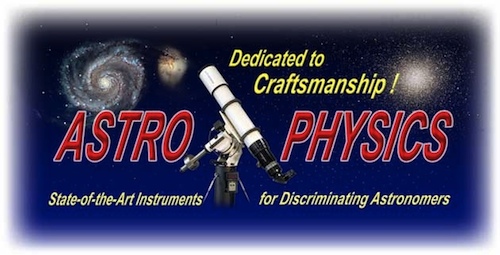
ASTRO-PHYSICS DESIGN AND PHILOSOPHY
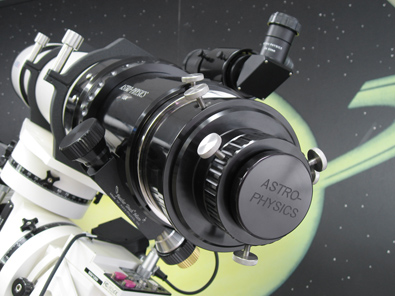 The name Astro-Physics has come to represent cutting edge telescopes and equatorial mounts, with a waiting list for their telescopes that extends for years. Even though Astro-Physics places few advertisements, their legend has continued to grow in the best way possible - by positive public critical acclaim. These have been proven to be superb products not only in published reviews and by our own estimation, but by the positive work published by their more demanding consumers. In fact a number of famous and awesome astrophotos (CCD and film) taken over the past decade or more have been accomplished by a number of Astro-Physics telescope owners. People often pay inflated prices to acquire a used Astro-Physics telescope (this happens with no other product line) just to have a chance to own that which most consider to be the best products in their class; this flattering inflation of prices while unwelcome, happens with no other products in this industry.
The name Astro-Physics has come to represent cutting edge telescopes and equatorial mounts, with a waiting list for their telescopes that extends for years. Even though Astro-Physics places few advertisements, their legend has continued to grow in the best way possible - by positive public critical acclaim. These have been proven to be superb products not only in published reviews and by our own estimation, but by the positive work published by their more demanding consumers. In fact a number of famous and awesome astrophotos (CCD and film) taken over the past decade or more have been accomplished by a number of Astro-Physics telescope owners. People often pay inflated prices to acquire a used Astro-Physics telescope (this happens with no other product line) just to have a chance to own that which most consider to be the best products in their class; this flattering inflation of prices while unwelcome, happens with no other products in this industry.
Right: Business end of the Astro-Physics 160mm f/7.5 EDF telescope (67,605 bytes).
Click on image to see enlarged view (204,264 bytes).
This is a product line that makes "Made In The USA" resound. The work of grinding and polishing the lenses, the lens coatings and the precision mechanical components are all entirely made by highly expert craftsmen in the USA. We invite you to visit Company Seven's showroom, the only full line Astro-Physics showroom in all the Americas (aside of the factory) where we show their product line including many other rare or discontinued telescopes and mounts.
ASTRO-PHYSICS APOCHROMATIC LENS DESIGN
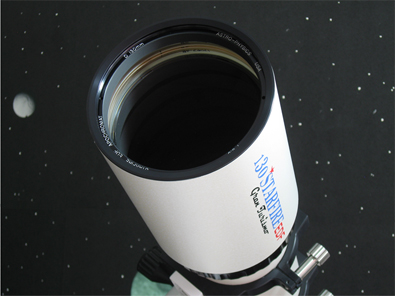 These objectives are APOCHROMATIC, which means that the images are essentially free of false color, both visually and photographically. Roland Christen selected Super ED to be the heart of his new optical designs because of its excellent light transmission and superior correction of all the monochromatic and polychromatic aberrations. Super ED is a more advanced glass than the more common varieties used in commercial refractors. It has allowed Astro-Physics to use crown rather than flint for the outer elements. Normal ED (FK01) and even Fluorite doublets use flint glasses as the leading element, causing the color correction to be less than perfect, especially in the violet region of the spectrum. These flints introduce false color that can be seen as purple halos around bright objects, or purple fringing along the Lunar edge and at the edges of bright craters. This color error can cause brighter stars to bloat on long exposure photographs.
These objectives are APOCHROMATIC, which means that the images are essentially free of false color, both visually and photographically. Roland Christen selected Super ED to be the heart of his new optical designs because of its excellent light transmission and superior correction of all the monochromatic and polychromatic aberrations. Super ED is a more advanced glass than the more common varieties used in commercial refractors. It has allowed Astro-Physics to use crown rather than flint for the outer elements. Normal ED (FK01) and even Fluorite doublets use flint glasses as the leading element, causing the color correction to be less than perfect, especially in the violet region of the spectrum. These flints introduce false color that can be seen as purple halos around bright objects, or purple fringing along the Lunar edge and at the edges of bright craters. This color error can cause brighter stars to bloat on long exposure photographs.
State of the art lens coatings technologies applied to the objective lens elements and computer aided engineered internal baffling facilitate the transmission of light through and between the objective lenses in a manner optimized to produce superb contrast and color fidelity. Looking down the barrel of one of these optical tubes reveals something resembling the blackness of Space with no reflections or opportunities for glare or ghost images to form.
Right: Antireflection coatings and baffling render the lens and tube interior virtually invisible on this Astro-Physics 130mm f/6.3 EDF telescope, even with its Lens Shade retracted (70,442 bytes).
Click on image to see enlarged view (204,340 bytes).
The Starfire EDT design (which includes the 105 Traveler EDT (EDF) telescope) consists of three matched optical glasses to combine the colors of the visual spectrum into intense, sharp, concentrated images. The views are extraordinary. As you can see on the specification sheets, the superb color correction of these EDTs and EDF surpass that of the fluorite doublets, particularly in the far violet part of the spectrum where Technical Pan films have their highest sensitivity.
The highly acclaimed Starfire EDF design has been available over recent years in 105mm, 130mm, 155mm, 160mm, 180mm, and world record 206mm diameter. These were developed with very fast focal ratios for amateurs who long to achieve superb, wide field astrophotographs. For avid astrophotographers, we offer the 155mm Starfire EDF, the new 160mm Starfire EDF and larger EDF refractors with giant 4" focusers to allow coverage of medium format films with minimal vignetting. In the hands of knowledgeable astrophotographers, these instruments can produce superb, professional astrophotographs of all your favorite deep-sky objects. Images are so sharp, it requires enlargements of up to 30 x 40 inch to resolve the finest details.
Their relatively compact arrangement makes the EDF series of telescopes truly one man manageable instruments; affording spectacular views unmatched by any other telescope systems in terms of field of view, detail, color fidelity, contrast and clarity. One of the important advantages of a short focal length is that the mounting can be relatively smaller, lighter and more compact than longer telescopes. The result is a highly portable refractor system with superior imaging qualities, ideal for a wide variety of astronomical work from high-magnification lunar/planetary to deep sky astrophotography.
OPTICAL PRODUCTION
Astro-Physics refracror telescopes are designed and manufactured in their modern optical facility in Illinois, so these telescope lenses are truly 100% AMERICAN-MADE. Using only precision "A" grade optical glass, which has high light transmission characteristics and is free of striae and imperfection. Each time they begin a new production run of lenses, Roland Christen computer-optimizes the design based on the particular melt characteristics of the new glass. Then, Astro-Physics opticians adjust the tooling accordingly to achieve the desired curves.
All lenses are polished on pitch and hand-corrected. Each lens is tested, polished and tested repeatedly throughout the production process. This continues until the desired performance is achieved. During the final figuring stage, the lens is evaluated with a laser interferometer. Mass-production techniques are not employed as it is impractical; each lens is treated individually. This process is very time-consuming, but there is virtually no other way to attain the level of resolution, definition, and contrast that the most demanding applications demand.
The combination of the apochromatic lens design, careful, precise optical production techniques, high-transmission multi-coatings and well-baffled tube assemblies results in a clean optical system with superior contrast and light grasp.
TUBE ASSEMBLIES
The Optical Tube Assembly Department at Astro-Physics carefully installs the baffles within the telescope tubes to insure that the placement is precise thereby effectively eliminating stray light. The interior of the tube is then finished with an anti-reflection black paint. Each lens cell and focuser are squared onto the tube in preparation for the final assembly and final collimation (alignment) of the telescope.Those larger telescopes designed with the astrophotographer in mind incorporate the Feather Touch dual-speed geared manual focus control. While the Focuser can be precisely rotated a full 360 degrees. These features allow more accurate focus, and the optimal composition of the image whether in the eyepiece or camera.
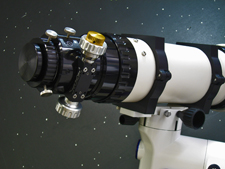
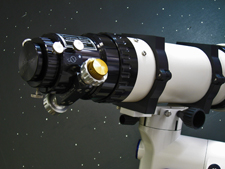
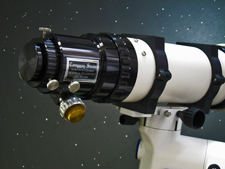
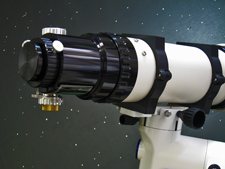
Above: Astro-Physics rotating 2.7 inch Focuser on 130mm Gran Turismo telescope with optional protective 2 inch Particle Wave DDCAP desiccant holder. |
MACHINING CAPABILITIES
Most of the mechanical components are machined in-house on ultra-modern three-axis CNC (computerized numerical control) lathe and CNC machining center. Highly skilled machinists maintain very accurate tolerances thereby producing components that uphold the Astro-Physics reputation for rigid mountings, precision tracking, smooth operating focusers, and unrivaled accessories.
GERMAN EQUATORIAL MOUNTS
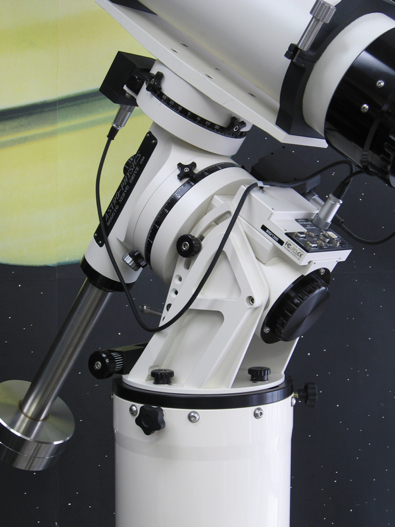
Well just as the telescope determines what can be seen or imaged, it is the mount supporting the telescope which determines how the telescope can be used. To match the potential of their telescopes Astro-Physics has developed and refined a series of German equatorial mounts which now culminate in the present revision of the 1200GTO, and their highest capacity tracking platform the 3600GTO. These refinements and engineering firsts come at breakneck speed from Astro-Physics since they have developed such a large following of advanced users of the product, and Astro-Physics has established an observatory at their own factory to help with research and development efforts. Considering the volume of constructive data returned by their customers to the factory from around the world, in all climates and most latitudes, and with their own unrivaled experience in this area (published photos prove these are not "armchair astronomers"), it is no surprise that the factory has expanded several times to try to meet yet increasing demand that hitherto has kept people in line for their products - but all while not compromising on the values that have kept Astro-Physics in the forefront of the technology.
Above: Astro-Physics 900GTO atop optional Particle Wave 'Pinnacle' model tripod displayed at Company Seven (220,019 bytes).
Click on each image to see enlarged view (315,524 bytes).
Astro-Physics equatorial mounts are designed for solid stability under a variety of observing conditions. At the same time, the mounts are truly portable so that amateurs can transport them to their favorite dark-sky site and set them up quickly and accurately. The mountings break down into manageable sizes, but when set up, they are extremely rugged and steady platforms. Astro-Physics has also developed a very accurate worm gear set and state of the art electronics technology to insure smooth, effortless tracking of celestial objects for all visual and photographic purposes, and a high degree of durability and reliability.
To achieve these performance criteria, Astro-Physics combined the latest technology with time-tested design concepts. The basic mounting configuration was engineered with proper vibration and strength of materials criteria. As in a good building design, all loads are channeled into massive load-bearing cross sections to their final destination - the ground. This is engineered in a manner that minimizes mass and size while maximizing rigidity. For examples of this, study the tension rods on the piers, and the thrust bearings on the polar and declination axes that transfer a tremendous amount of load in relation to their size. To these mechanics is added a drive that is accurate and sophisticated enough for the most demanding application, featuring a custom-manufactured fine-pitch worm gears driven by a high-resolution stepper motor with an advanced hand held controller. This makes the tracking of celestial objects a snap, even for beginners.
MOUNT ASSEMBLY
The Mount Assembly Department is staffed by professional telescope makers who are advanced users and observers. Their experience is brought to bear during the design, fabrication, and final assembly of each mounting. During assembly, the staff works diligently to assure the mount adjustments (many done by "feel") are nominal. And here is where the hand controller and motor components are carefully assembled, with components being soldered to the circuit boards, and all components tested prior to shipment.
ACCESSORIES
Astro-Physics telescopes are complemented by the most comprehensive, custom matched series of accessories and options that make these telescopes particularly versatile. From CCD imaging to 35mm and medium format film camera adapters to photo-visual telecompressors, these have carefully designed for functionality and compatibility. They are all tested and proven in the field under actual observing conditions, and available at most reasonable prices.
Contents Copyright 1994-2011 Company Seven - All Rights Reserved

